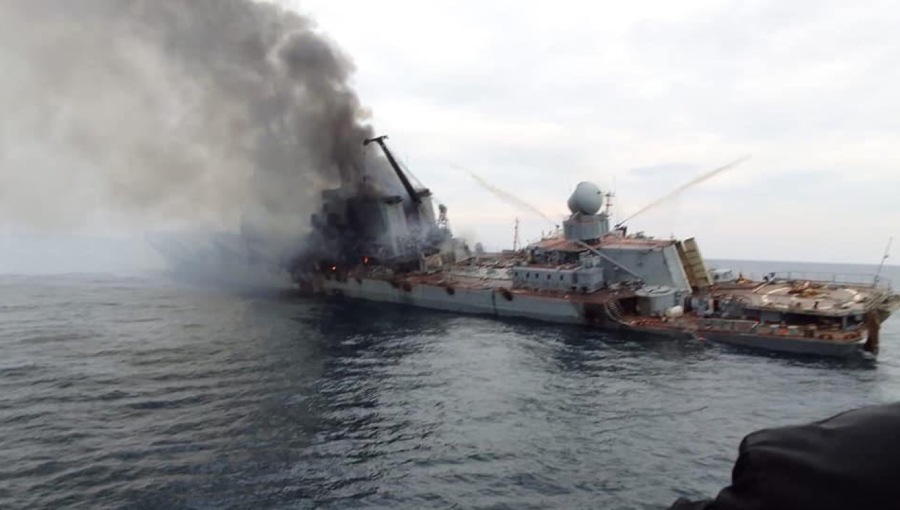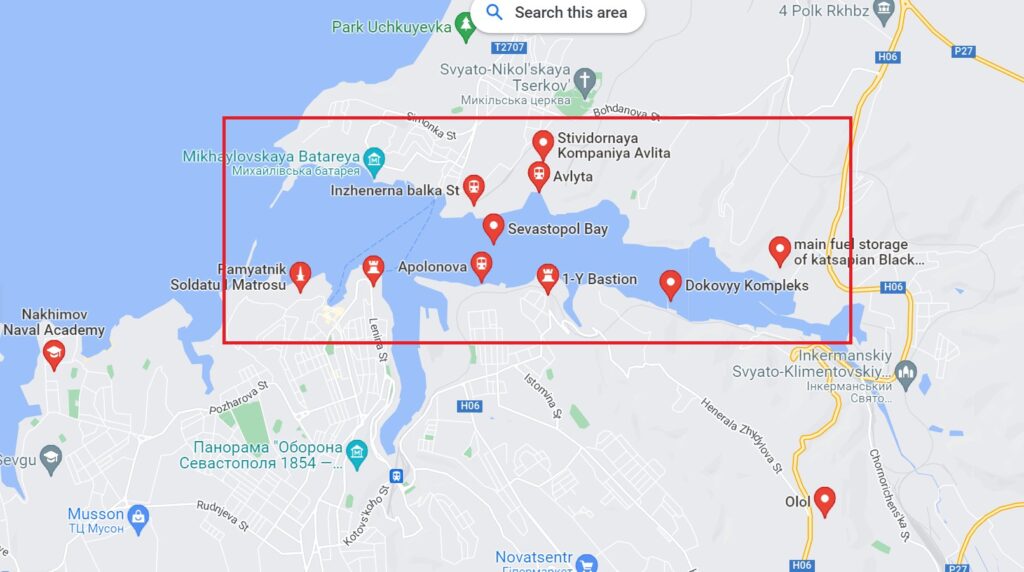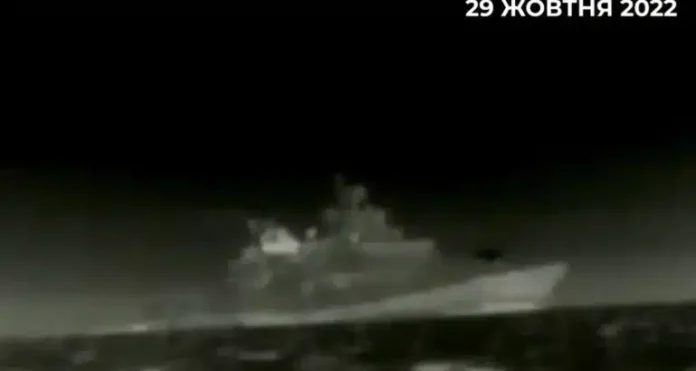Ukraine conducted a new surprise attack on the Russian Black Sea Fleet on October 29, 2022. This time, it targeted naval combatants at the Russian naval base of Sevastopol, opening a new era of naval warfare by using unmanned surface vessels (USV) as suicide drones.
The Russian Black Sea Fleet (BSF) was awakened by a shocking drone attack on Saturday morning. Ukraine targeted naval units in and around the main Russian base in the region, the Sevastopol naval base.
According to the footage circulating on social media, Ukrainian unmanned surface vessels (USVs) carried out kamikaze attacks on the BSF units. An Admiral Grigorovich-class frigate, possibly the flagship Admiral Makarov, and mine countermeasure (MCM) ship were reportedly hit by the Ukrainian USVs.
The reports suggest that Ukraine attacked the base simultaneously with UAVs and USVs. According to a Russian Defense Ministry statement, 8 UAVs (Unmanned Aerial vehicles) and 7 USVs were involved in the attack. The Russian Defense Ministry claimed that all UAVs and four USVs were repelled by the BSF units, and three USVs were destroyed on land. The Russian Defense Ministry stated on its official Telegram account that only one MCM vessel, Ivan Golubets, was slightly damaged in the attack. But according to the footage, the reality looks different. The USV targeted the Admiral Grigorovich-class frigate which didn’t seem to apply countermeasures against the drone.
In the same statement, Russian MoD said that the naval units attacked by the drones were providing security for the merchant ships carrying grain at the grain corridor for months. A few hours later, Russia suspended its participation in the grain deal, which was considered to ease a possible food crisis due to the Russo-Ukrainian war.
“It should be emphasized that the ships of the Black Sea Fleet that were subjected to a terrorist attack are involved in ensuring the security of the “grain corridor” as part of an international initiative to export agricultural products from Ukrainian ports.”
Russian Ministry of Defence
Asymmetric Threat: The Fog of War

Though the asymmetric assault threat has been a part of the battle tactics in every domain for decades, the importance of force protection was better understood by the navies after the USS Cole incident, which was attacked by the terrorist group al-Qaeda while she was refueling in the Yemeni port of Aden on October 12, 2000.
This incident has shown the significance of such threats, and in particular, NATO allied naval forces have begun to develop additional measures against such threats from the air, surface, and subsurface. This is because such attacks can occur at the ships’ weakest times, such as when warships are resting or replenishing and not as ready as when they are deployed at sea, or when they are operating close to shore, passing through a strait, and so on.
These low-cost solutions have also led several navies to develop small boats to take on larger navies, such as Iran, which has hundreds of manned/unmanned armed boats to defend the Strait of Hormuz and the Gulf. This is because it is not easy for even a destroyer to deal with a swarm of drones, as they are usually designed to engage combatants. Warships have firing channels for cannons and missiles. Although they can destroy some of the drones with these weapons, their firing channels would not be enough if they were attacked by dozens of boats or ammunition lying around. Therefore, fighting these boats is still a problem for large naval units.
The Miracle of Ukraine

Ukraine took the asymmetric threat to a new level by attacking Russian ships at their mother base with the kamikaze USVs. This attacking style was quite unfamiliar in naval warfare, though the navies have been working on the CONOPS (concept of opreations) to use these assets as a part of the manned fleets.
Ukrainian forces are skillfully using the means at their disposal to optimize the timing of the asymmetric operation. First of all, it should be underlined that the Ukrainian Army, trained in the doctrines of NATO by the U.S. Navy during Sea Breeze exercises, unlike the Russian Army, can effectively use its air, land, and limited sea power to neutralize both strategic and asymmetric targets in joint operations.
As in the case of the striking of the Crimean bridge, which is strategically important for the Russians, the Ukrainian forces attacks critical targets in order to gain psychological superiority and damage the reputation of the Russian Armed Forces.
The sinking of the Black Sea Fleet’s flagship, the Moskva, also psychologically destroyed the Russian Navy. After this incident, Admiral Makarov was appointed as the new flagship. Ukraine, a country without naval forces, fired twice within a few months at the flagship of a powerful naval force.
The damage to the new flagship Makarov, as a result of a plan developed with a common understanding of operations and the product of very good intelligence work within the logic of the network-centric operation, is a great success for Ukraine and a reason for failure and shame for Russia.
Ukraine’s use of USVs for kamikaze attacks already took a place in Naval Warfare.
Black Sea Fleet: A Naval Force Which Doesn’t Learn

While the Russian BSF has strong submarine power and surface assets fitted with strategic missiles, it lost many ships as a result of coastal missile attacks, TB2 drone strikes, and so on. Many analysts and navy professionals criticized the Russian negligence after it lost its mighty flagship Moskva and a large tug with Ukraine’s missile attacks, patrol boats with TB2 drone strikes. Russia insisted on the wrong course of action, and made such mistakes;
- Russian intelligence failed to detect Ukraine’s coastal missile batteries were operational on the coast, so the Moskva had to be deployed outside the effective range of those missiles,
- Although the U.S. has officially stated that it has provided Harpoon missiles to Ukrainian forces, Russia has sent a rescue tug to Snake Island, and the ship has sailed in the A2/ AD area of these missiles,
- BSF lost area air control after losing Moskva, but insisted on sending small patrol boats with weak air defenses and lost several boats to TB-2 Bayraktar drone attacks.
These are rare incidents that would be subject to the naval academies of the countries, just like the lessons of the Falkland War are still considered fundamental for many applications in Naval Warfare. Naval battles don’t occur often in history, many naval officers from different countries around the world retire without facing a real conflict at sea. For this reason, it is possible that warships might not show the necessary reaction the first time they encounter real aggression, but even if they do, it may not be sufficient.
This is because the dynamics of the exercises and the real conflict are very different. While the focus is on practicing like fighting, the lessons learned from real battles are worth their weight in gold. In this case, Russian losses become more interesting. When they lose the first ship (even if it is the mighty cruiser Moskva), even though there is a lot of carelessness, it can be understood because the Russian Navy (like many of other navies) did not have hot contact with a real adversary for decades. But the loss of the other ships by repeating the same (or similar) mistakes shows that the Russian BSF cannot learn from such disasters.
Firstly, Ukraine’s USVs were detected when a USV was aground on a Sevastopol beach. Among the other analysts, Naval News correspondent H I Sutton analyzed this drone and underlined that this can be used as a weapon. This could be the first warning to the BSF, that Ukraine has plans to strike naval units in the Sevastopol base. In this case there would be two common possible courses of action for the Ukrainian forces;
- Proceeding with the USVs from the channel from the west close to the shoreline and attack when establishing hot contact with the Russian units,
- Transporting the drones secretly via land, and deploying them to the sea in the vicinity of the base.

In the first scenario, it is unacceptable that these drones cannot be detected before they pose a threat, because Russia has been at war for 9 months and should be on alert to protect key bases and facilities, and the waterway is long enough to detect and engage the boat before it attacked. The second scenario takes place in a location that is under Russian control. Therefore, security forces and intelligence should be prepared for sabotage attacks.
The footage suggests that the Russian units (probably helicopters) were trying to engage the USVs with guns, but, it’s not easy to hit such a small and fast boat with classical weapons. In this case, detecting the boat early, and engaging them with smart munitions or missiles seem indispensable.
In addition to these issues, measures to protect the Sevastopol base should be strengthened after the first drone was detected 5 weeks ago. Moreover, the ships had to take the necessary measures to repel such a surprise attack. As we mentioned in the previous subtitle, an asymmetric threat is not easy to repel, but Russian ships had to strengthen security measures, especially at night, when ships are more vulnerable because they are at war. So they had to consider all the possibilities.
Conclusion
Russia is a country with a maritime culture that has carried out successful harbor raids in its history. The fact that this navy’s warships were damaged by Ukraine’s attack, which deprived it of almost all naval forces, shows that Russia lacks basic capabilities such as port protection, reconnaissance, and accurate assessment of the enemy’s capabilities.
Every war sheds light on future conflicts, thanks to the lessons learned in it. What happened to the Russian Navy in the Black Sea shows that expendable USVs and UAVs will pose a major threat to multi-million dollar ships. In future conflicts, it will be even more difficult for ships that are not equipped with effective protection and survival systems, and drone swarms will be a major problem for large combat ships.




